During our visits to the Beira, a side trip Ciudad Rodrigo (pop 12,065 in 2021) is a must (in 2021 and 2023). For this revisit, our plan is to break for lunch there on our way to a new destination, Salamanca.
On a day with iffy weather, we catch some sunny breaks. We do our best to time our day so that the driving coincides with the anticipated showers.
On our way to the Catedral, we notice that the local correos is open – it had been closed during our last two stops (his is the corner-entry building very near the Puerta de Santiago). The building is known as the Casa de los Vásquez (16th century), and the interior, while converted for use as a post office, is spectacular – full of lively details, bright tiles, and stained glass.
Otherwise, Ciudad Rodrigo is as we remember; the streetscape is a bit 'monochrome' compared to Portugal, but full of textures and ironwork. We walk around the Iglesia de San Pedro (16th century) and head for the Napoleonic era star-fortress walls (18th century).
We walk from the Puerta del Sol at the far eastern end, along the top of the northern parapet, to the Plaza de Herrasti on the west. We have just enough time for a quick look in at the Catedral.
The Catedral de Santa María (12th century) is also due another look, as we did not go inside in 2023. The route begins in the claustro (14th century), where we notice all the faces dotting the infill of the gothic vaults. We imagine the friars walking in the company of these little souls.
The visitor's pamphlet contains a QR code that links to this web page. The 'Historia' page at that same site says,"the southern and western galleries were constructed in the 14th century while the northern and eastern galleries were constructed in the 16th century". And a close inspection confirms this; there are no capitals in the arch screens on the north and east – the screens appear higher, cleaner, and more 'modern'.
The web page mentions one of the capillas laterales and we can take a closer look. The Altar de Alabastro or "La Quinta Angustia" (Lucas Mitata, 1560) features a pietà relief image. Below the family crest and dedication to Fernando de Robles and María Pérez Piñero, and just above the pietà, a small roundel shows Christ carrying the cross. And just below the pietà, two angels hold la Santa Faz.
The Pórtico del Perdón ('portal of forgiveness', 13th century) is always worth another peek. Though we had noted the capitals in our previous tour, we now see that the outer archivolt represents the 'Last Judgement'. Scenes of the dead emerging from their tops spill down each side, and trumpeting angels announce the Apocalypse. On the left (on the right of Christ), an angle welcomes them to the afterlife, while on the right, wicked demons grab the unworthy and throw them into a pot, to become a meal for the Beast.
Like those in Seville and Granada, a Spanish cathedral puts the coral (Rodrigo Alemán, early 16th century) in the middle of the nave. The stalls are covered in fantastical grotesques and obscene figures and may contain one of history's oldest 'poop emojis' – digging up that one makes the revisit totally worthwhile.
After lunch, the skies being to fill with clouds; time to hit the road. We pause to watch the Río Águeda
pass under the Puente Mayor.
Then we walk the short distance from the Castillo de Enrique II (14th century) to the Plaza Mayor, to the Puerta de Santiago.
The rain is just about done when we arrive in Salamanca (pop 144,825 in 2020); a drizzle accompanies us from the parking garage to the hotel. After we unpack, the clouds are clearing, and we head down to La Plaza de la Libertad (19th century) for a snack.
The plaza is the garden left from the former Convento de San Elín de los Carmelitas Descalzos. From the satellite view, it seems like a sandy square surrounded by shrubs, but the shrubs are in fact rangy trees (unpredictable Z-axis). The architectural palette is the same as in Ciudad Rodrigo: mono-tonal stone, beautiful ironwork, and glassed-in balconies.
We watch as the birds vanish in and out of the dense foliage, Field of Dreams style.
The Plaza Mayor (18th century) is just a few steps away. It's paseo time, and the grand square is filling with older couple arm-in-arm, and families pushing strollers. The arcaded blocks are a standard four-story height and layered with iron railings and shuttered doorways.
The Ayuntamiento (city hall) centers the north gallery, standing forward and taller, and capped by the town's clock and bell tower. The Arco de San Fernando is to the east and is the only other element to break the height of the cornice. Cafe tables and umbrellas crowd the southern corners. Between the arches, a series of relief portraits enliven the eye line.
The space is remarkably clean. The walls wear an honest patina, and everything is well-kept and in astonishingly good shape. The Plaza is simply lovely.
The Arco de San Fernando leads out to the Mercado Central (Joaquín de Vargas y Aguirre, 20th century), which is just closing for the day. We step in for a glance before the attendant locks up, and snap pictures of the colorful interior.
On the other side of the Plaza del Mercado is the Las Casa de los Flores (early 20th century), with its graceful, shimmering, circular tower and dome. This building houses the Patronato Municipal de la Vivienda (housing authority).
We make a loop through the Plaza and around the Mercado, getting acquainted with the city. Just behind the Casa is the imposing and ancient tower of the Iglesia de San Julián (12th century).
We arrive in the Plaza del Poeta Iglesias. A rising, conical stairway leads to the southeastern arco; the tables and umbrellas of the Plaza Mayor spill into this corner.
Up the hill, we find the Iglesia de San Martín de Tours (12th century). The south facade features a Renaissance-era triumphal archway, La Puerta del Mediodía (1586): the corner medallions show San Pedro (keys and San Pablo (sword), San Martín (on horseback, sharing his cloak), and near the top is the Pantocrátor.
The composition is capped by stacked bells and birds' nests – the design seems to incorporate large 'baskets' to accommodate the storks.
The west facade encroaches on the narrow Plaza del Corillo, where an older doorway hangs above the street. The lower row of blocks slumps mid-span, possibly the result of the Great Lisbon Earthquake.
From here, we peer down the Calle Rúa Mayor towards the Catedral, with the shades of the setting sun washing the clouds.
After an enjoyable dinner, we take a late evening stroll to see how the city changes at night. The lights in the Plaza Mayor pick up the rhythm of the architectural bays and perform an alchemy that transforms 'sand' to 'gold'.
Most of the shutters are closed, smoothing the surface and reflecting the light. The contrast gives the details extra punch, especially at the Ayuntamiento and all around the upper balustrade where the finials point into the darkness.
We head down the Calle Rúa Mayor, where the towers of La Clerecía (17th century) grab our attention. We turn the corner of the Calle Rúa Antigua and discover La Casa de las Conchas (late 15th century) across the street.
The classical details on La Clerecía, and the gridded conchas of La Casa are amazingly crisp. Are the carvings four hundred? six hundred years old? It challenges credulity; they must have been replaced – surely.
We continue to the Iglesia de San Sebastián (18th century), and on the south side of the Plaza de Anaya, the Catedral Nueva (16th century).
Here we pay a price for the sharp stonework, as the main entrance, La Portada del Nacimiento (16th century), is shrouded by scaffolding. Still, we can make out the Nativity (above the north door), the Three Magi (above the south door) and the Crucifixion (top of the arch).
Further south is the Catedral Vieja (12th century), attached along its north edge to the Catedral Nueva. The domes over the two crossing define the two architectural periods. The wonderfully corbelled dome of the older church, El Cimborrio, is topped by a gallo – looking somewhat Portuguese next to her taller Spanish sister.

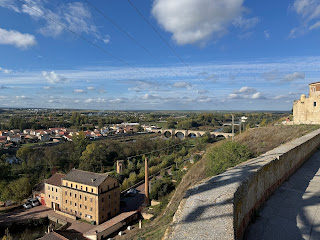









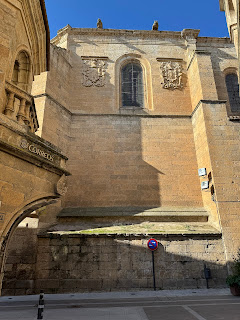






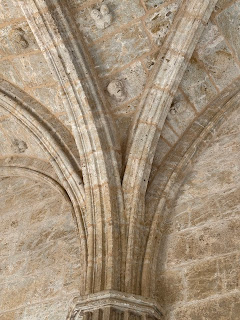

















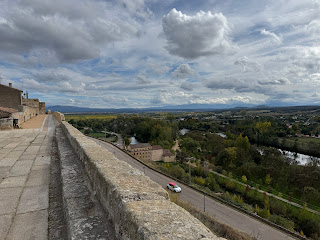


















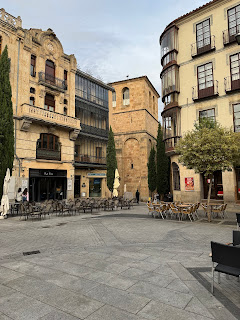


























No comments:
Post a Comment